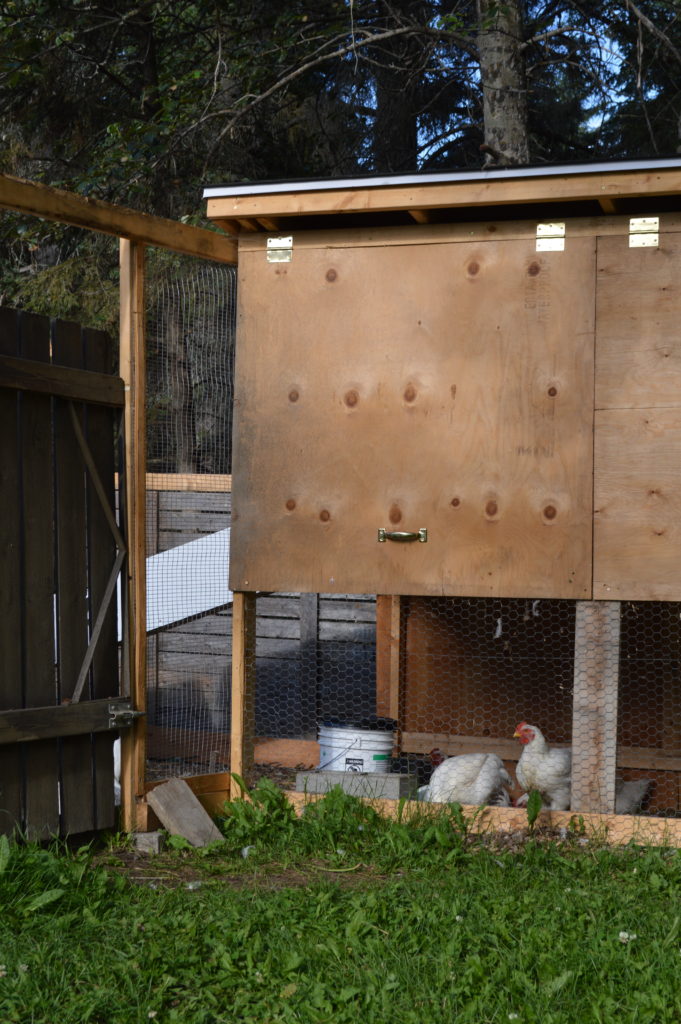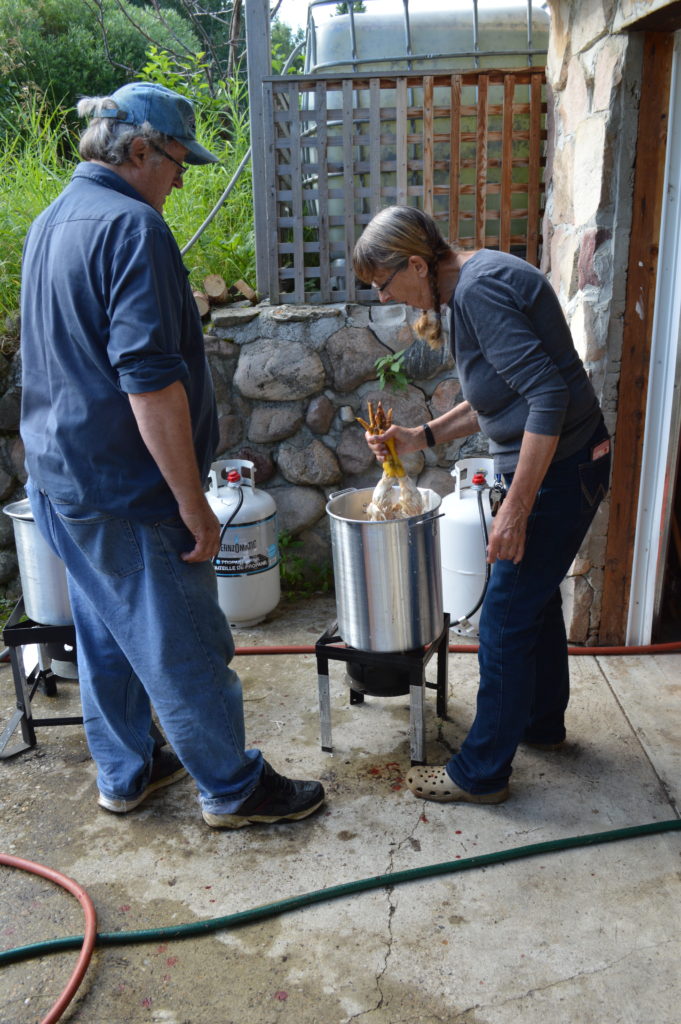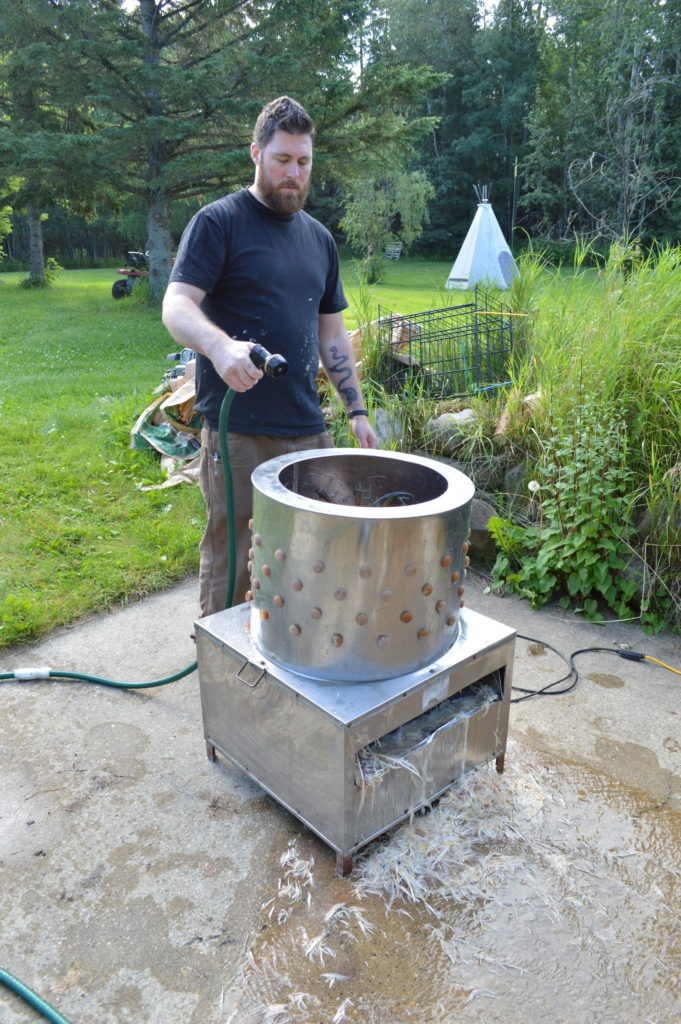
Last week I helped with a chicken harvest for the first time. My parents-in-law had raised twenty eight birds to maturity on their property in Lac St. Anne County.
The chickens were killed with an axe to the neck, severing the head.
After a couple minutes of twitching the bodies were held by the feet and dipped in steaming water to loosen the feathers. We had two “turkey fryer” propane burners heating 5 gallon pots of water to 150°F. The chickens were dunked a few times, just until the wing and tail feathers pulled out easily, which took less than 60 seconds. If done properly this helps the feathers release easily in the plucking machine, without cooking any of the skin or meat.

The scalded birds were then transferred to a plucking machine that had been rented for the day. A plucker is a rotating drum, kind of like a washing machine, with rubber pegs all along the bottom and inside wall. These pegs pull the feathers off as the bird tumbles around within. Cold water is sprayed into the drum as it spins to wash the feathers out the bottom. If the bird has been properly scalded this machine does a fantastic job, remove all feathers without damaging the body. On some of the birds the joint between the wing tip and drumette was snapped, but otherwise the plucker is quite gentle.



The plucked birds were then taken to a work bench to be eviscerated. This was my station. First I removed the feet. The the joint between the feet and drum is very similar to that between the drum and thigh: simply cut through the skin and you can snap through easily. Then I flipped the chicken onto its belly to remove the preen gland. Officially this is the uropygial gland, but it’s also sometimes called the oil gland or scent gland. Looking at the back of the bird, just above the tip of the pope’s nose, there is a small nipple-like structure called a papilla. During the chicken’s life oil is secreted from this nipple to be rubbed over the feathers. The gland itself is beneath the nipple, extending a short way up towards the head. This gland is removed because of its strong taste.
Then the real fun of the eviscerating begins. The goal is to remove the entire digestive tract in one piece without rupturing anything. For food safety reasons we want to keep what’s inside the digestive tract away from the meat. This was my method:
- With the head already removed, the first part of the digestive tract is the crop, a kind of pouch on the neck of the bird. Since the birds weren’t fed the day before the kill, the crops were generally empty. In this case the crop can be left in place. It will be pulled out with the esophagus later. In game birds the crop is often very full and won’t fit through the gap between the neck and collar bone (wish bone). In that case I remove the crop first.
- Carefully cut all around the anus. Don’t cut too deep or you maybe nick an intestine.
- I worked with a pail under the edge of the table. Once the cut is made pull out the anus and bowel so it is hanging over the pail.
- Reach up into the cavity and locate the liver.
- Reach up into the cavity and locate the gizzard. Pulling the gizzard out will bring most of the intestines out too, but be careful as some of the tract just “upstream” of the gizzard is delicate and can break.
- Usually at this point you can reach the heart and it can be pulled out.
- Reach up to the esophagus. It is quite sturdy and you can pull it all the way through the gap between the neck and wishbone.
- At this point the entire digestive tract should be hanging out the cavity. Cut off the gizzard and set it aside to be cleaned.
- All that should be left in the cavity are the lungs and kidneys. The lungs are well-stuck to the inside back ribs, quite high in the cavity. With a little effort these can be scooped out with your fingers. The kidneys are shaped like small beans and are farther down the back inside ribs and detach easily.
At this point the empty cavity is rinsed with cold water.
The chickens are then submerged in an ice bath until the meat is thoroughly chilled.
We double bagged our birds, using a shop-vac to remove as much air from each of the bags as possible. Then they need at least 24 hours in the fridge before transferring to the freezer. This gives the meat a chance to go through rigor mortis and then tenderize.